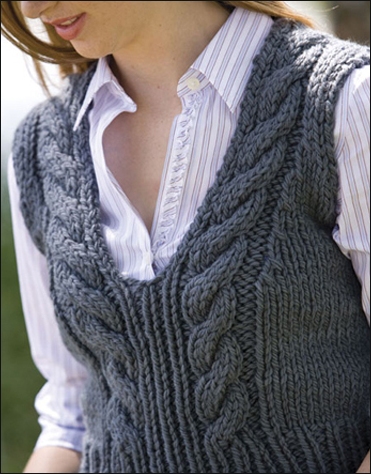 Title: Simple Style
Title: Simple Style
Author: Ann Budd
Publisher: Interweave Press
Hard-bound: 136 pages
Price: $16.47 US/£12.99 UK
Available from: Amazon.com and Amazon.co.uk.
Simple Style, the latest pattern book in Interweave’s popular ‘Style’ Series, is ‘a collection of nineteen contemporary garments that celebrate stunning results without the intricate techniques’. I can’t imagine that there’s a knitwear designer anywhere who isn’t interested in simplifying his or her patterns, so it’s intriguing to see what this book can offer. Impressive as complex designs can be, it takes a really skilled designer to use basic knitting techniques to their fullest advantage, whether decoratively or structurally. There are seven cardigans, seven pullovers, three sleeveless tops, two skirts, and a jumper (or pinafore, if you’re British) presented in Simple Style. The designs are simple but not bare; uncomplicated stitch patterns are used to embellish the pieces without creating anything very showy, and as such it follows that the garments are for daywear, though there is a blend of casual and austere patterns suitable for different occasions.
Ribbing is a favourite in many of the designs; the ‘Organic Cotton Henley’ uses a few rows of ribbing to stop stocking stitch curling (a neat little trick I feel the ‘Kokopelli Jacket’ could also have benefited from). Extending ribbing up from the hem in a V-shape is a technique the ‘Sixteen-Button Cardigan’ and the ‘Twisted-V Pullover’ employ, and the effect is both decorative and slimming.
The ‘Tailored Vest’ uses ribbing in lieu of waist-shaping, placing elastic 1×1 ribbing on either side of the vest to provide a custom fit for the wearer, while the ‘Kazumi Pullover’ draws attention to the decreases and increases of the waist-shaping by letting the ribs dip elegantly in and out of the side seams. The pullover is knit in 80% bamboo yarn, allowing it to drape rather than cling, and bubbly yarn-overs and picot cast-ons add a bit of lacy delicacy to the hem and cuffs.
 The ‘Empire Swing Cardigan’ also makes use of the drape of wide ribbing, and adds a gentle flare by using progressively larger needles. Ribbed garments often have an unfortunate tendency to highlight curves in all the wrong places, so I think all of these designs do an excellent job of working to flatter a variety of figures. Having said this, not all patterns are written in a wide range of sizes, with ‘Kimono Classic’ having as few as two sizes to choose from. Patterns have also clearly been chosen to showcase an assortment of yarns. The ‘Four-Quarters Pullover’ (pictured on the cover) and ‘Kaleidoscope Pullover’ are great for showing off striping yarn to its best advantage (a perennial challenge for knitters), and the ‘Big Cable Vest’ is great for bulky yarn.
The ‘Empire Swing Cardigan’ also makes use of the drape of wide ribbing, and adds a gentle flare by using progressively larger needles. Ribbed garments often have an unfortunate tendency to highlight curves in all the wrong places, so I think all of these designs do an excellent job of working to flatter a variety of figures. Having said this, not all patterns are written in a wide range of sizes, with ‘Kimono Classic’ having as few as two sizes to choose from. Patterns have also clearly been chosen to showcase an assortment of yarns. The ‘Four-Quarters Pullover’ (pictured on the cover) and ‘Kaleidoscope Pullover’ are great for showing off striping yarn to its best advantage (a perennial challenge for knitters), and the ‘Big Cable Vest’ is great for bulky yarn.
My favourite design is probably the ‘Offset Raglan’ by Véronik Avery, a simple everyday piece which would knit up very quickly. The clean, boxy silhouette of this asymmetrical cardigan is preserved by using hook-and-eye closures instead of buttons, keeping the ribbing unbroken by buttonholes. The design is seamless and beautifully balanced, with both vertical and horizontal bands of ribbing knitted to the same width. I also found myself thinking seriously about knitted skirts for the first time. I think many knitters are rightly dubious about the merits of the knitted skirt, but Kat Coyle’s two skirt patterns have lovely A-line silhouettes that are reinforced by seams, edgings, and (in the case of the ‘Guernsey Skirt’) a sewn waistband to ensure a good fit.
The photos in the book aren’t particularly inspiring, but they do illustrate the garments very well, and all instructions and charts are presented with a clarity customary to Interweave publications. Not all designs will please trendy young knitters, but there are a few (‘Sixteen-Button Cardigan’ and ‘Tailored Vest’ among them) that I think have that ‘classic’ quality which will allow them to endure as sylish knits. I think it’s important to note that the simplicity of the designs doesn’t necessarily make them easy, beginner patterns. Although the ‘Design Notebook’ (a staple of the ‘Style’ series) explains how edgings, seams, and stitch patterns have been minimised, and shaping has been separated from colour and lace patterns, the absence of complex design elements draws attention to the details of paired increases and decreases, selvedges, seaming, and getting correct gauge. The ‘Design Notebook’ therefore emphasises the importance of finishing techniques, which a new knitter may otherwise underestimate. The secrets to simplifying your knitting detailed in this section can also help you design or modify your own patterns. Even if you decide not to knit any of the patterns in Simple Style, I think it’s a good book to have around, to remind you of those simpler alternatives.
 Derya hails from Wales. She frequently sits and knits, designs all kinds, and writes in bytes. She’s quite experimental, and knits continental. You can find her wares and wherefores at Laylock.
Derya hails from Wales. She frequently sits and knits, designs all kinds, and writes in bytes. She’s quite experimental, and knits continental. You can find her wares and wherefores at Laylock.
